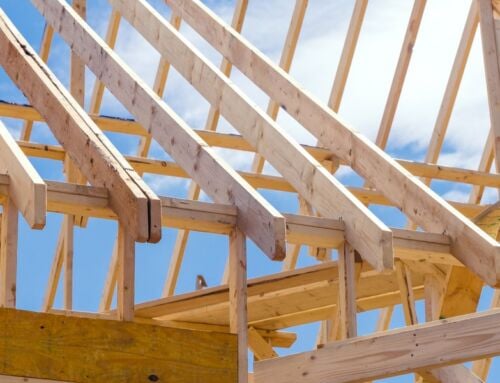As Canadians continue to spend most of their time at home during the COVID-19 pandemic, interior design and renovation has been a way for many homeowners to be more productive while making the most of their space.
Canadians are rediscovering their homes, and many believe that the next few years are going to be spent working from home. Office spaces and outdoor areas like patios are popular spaces to renovate. A RE/MAX Renovation Investment Report released in April 2021 highlights that more than half of Canadians renovated their home in 2020. Almost 30 per cent of those surveyed did so to enhance their lifestyle for aesthetic or recreational purposes, compared to only 16 per cent who renovated to increase the market value of their home.
This surge in home renovation has come at a difficult time for the residential construction industry, as contractors struggle to meet demand for labour and materials while complying with strict health and safety standards that often change. Because many homeowners opt to renovate several areas at once, additional pressure is placed on the industry and the supply of resources and materials.
A home renovation project involves juggling many complex, time sensitive tasks. We spoke with the Ontario Home Builder’s Association (OHBA)to put together a list of risk management tips your contracting business can use before and during a renovation project.
Before you start a renovation
There are a few key steps to take before your renovation begins:
- Getting the right permit
- Understanding your client profile
- Setting expectations
Getting the right permit
It’s important that your business applies for the right permit, which will depend on the type of work you are doing. The general rule of thumb is that a permit is needed any time you deal with structural change, such as an electrical panel issue, installation of new plumbing, or fixing drainage issues. In most cases, a permit is not needed for general maintenance such as changing light fixtures.
Certain regions, like the city of Toronto, may have different rules and regulations. For example, if you’re a contractor based outside of the city working on a renovation in Toronto, it’s important to understand their rules. This is key, especially if you’re looking to expand as a business.
Understanding your client profile
Many businesses get involved in contractual arrangements without understanding their client’s profile. The OHBA recommends creating a client profile to define key factors such as age, gender, household income, location, type of neighbourhood, how long the clients have been homeowners for, and if they want a remodel or custom home. This important exercise can help you understand who your ideal customer is, especially if you are new to the industry. It can help you tailor your marketing and sales tactics to target this audience and help understand where your strengths and weaknesses are as a business.
It may also help to understand the neighbourhood you will be working in, and what response you might get to any type of outdoor construction. If trucks are coming in, you may have to inform your client so they can give their neighbours advanced warning.
Setting expectations
When you create the contract, make sure your client clearly understands what type of work is going to happen and what the payment requirements are. You should also include what will happen if there’s a dispute or delay during the project, along with possible solutions.
It’s important that you and your client understand how the contract works. Active communication from both of you at every stage is important. As the contractor, you need to communicate what you need, usually a day or two in advance of the job. As the client, they need to communicate concerns as soon as they arise.
Most common challenges during a renovation
Once you have secured all the necessary permits and a signed contract, you can begin to tackle your renovation. It’s important to understand that no matter how prepared you are, you may still face challenges along the way. Establishing open channels of communication and building a relationship with your client can help you get the job done well.
Renovations are an intimate business – when you’re working in someone’s home, you’re in their personal space. Every time you leave, they’re going to walk around and look at what you did. This may lead to misunderstandings, but there will also be moments of clarity.”
As a business, it’s your responsibility to manage client expectations when there is a setback. For example, if a client picks out a kitchen counter that becomes unavailable even though you, as the contractor, said it would be, it’s your responsibility to ensure the client receives clear communication and still feels like they’re getting what they want. First, tell them about the situation. Show up with options and solutions. If it isn’t available for the next twelve weeks, you can suggest another material in the meantime. You can also suggest options that you have confirmed will be available sooner, and let the client decide.
Compensation may be another issue your business may run into during a renovation, which is why it’s important to clearly define the payment structure in your contract beforehand. It’s common practice to outline a process for draw pay, which is an advance of money held and paid on a predefined date.
Clients will often question the draw pay, especially when you can’t show up to do the work – this may be due to COVID or other restrictions. It’s important to explain that the draws are set up this way because you have supplies sitting in storage that your business needs to pay for.
Here is an example of what this could look like:
The total cost of the job is $<insert number here>. We need 15% before we start, and four draws over the course of <insert time period>.
Money can be a sensitive subject, so include specific wording about when you need a deposit and how the rest of the payment will be collected. Finalize this contract, so that even if there is a bump in the road, you still get a draw. All that changes is your final invoice.
Tips to help minimize expenses
From labour to materials and equipment costs, taking on a home renovation project as a contractor can be costly. Keep these tips in mind to help get the most out of your budget:
- Storing materials onsite
This can help keep your costs down while showing owners exactly what they paid for. For example, being able to deliver hardwood a week before it has to be installed shows your client what they’re paying for.
- Just in time deliveries and payments
A just in time delivery is when you make a purchase just in time – for example, if you don’t need a certain material until Wednesday, order it on Monday. If you order it six weeks ahead of time and it comes too early, you have to find a place to store it and pay for it before it’s necessary.
- Scheduling work
If you can, arrange your schedule so that workers you need to supervise are onsite at the same time. For example, if you have an HVAC person and supervisor coming in, try and schedule them both at the same time. If you’re going to be there to supervise one, you should try to arrange the schedule so that you can supervise both.
- Setting a contingency period
Be clear about how long the reno will take, keeping in mind the possibility of delays. If it’s going to take eight weeks, give your business ten to get the job done. This give you a two-week contingency period in case something goes wrong.
The impact of COVID-19
Like many other industries, the impact of the COVID-19 pandemic on the residential construction industry has been significant. The OHBA reports that the pandemic has completely disrupted the regular flow of work. Now, any project that requires more than six weeks to get done is almost guaranteed to see a delay of some sort. Clients generally understand that their project will take longer.
For example, if a homeowner suspects there is a risk of contracting COVID-19 and doesn’t want workers in their house for a two-week quarantine period as a precaution, this can create a contractual issue.
In this case, as the contractor, you would have to reschedule, which could be difficult as you might book projects in advance. You may not want to leave a job half finished, but if you don’t have access to the workplace for two weeks, you may have to move on to the next job.
The demand for materials such as lumber and drywall has also presented issues for contractors, as there isn’t enough to go around at the moment.
Staying compliant with health and safety guidelines
Along with health checks of all workers and appropriate sanitation and masking efforts, homeowners must provide contractors with explicit permission to enter their home. While work is in progress, the area should be quarantined, and the homeowner should not be allowed in the work area.
If the client wants to inspect it after you leave, they should also have to abide by protocol. This means wearing a mask and wiping down the space. They should tell the contractor that they entered the workspace. When workers come back the next day, they will then have to go through the process of sanitizing it again.
Contractor’s insurance can help protect your renovation project
We partner with leading industry associations, including the Ontario Home Builder’s Association (OHBA), to make sure businesses in contracting and skilled trades have reliable coverage when they take on projects like home renovations.
A tailored insurance solution can help safeguard your business against the unique risks that could derail your project, such as liability, auto, and property losses. Learn more by visiting our Contractor’s Insurance page today!
About the Ontario Home Builders Association (OHBA)
The Ontario Home Builder’s Association (OHBA) represents the residential construction industry in Ontario, with 4,000 member companies organized into 27 local associations across the province. They provide resources and support for businesses taking on home renovations. To help businesses continue to operate during the pandemic, they have created a COVID-19 renovator guide with information about health and safety protocols and tips on how to communicate with homeowners.
This blog is provided for information only and is not a substitute for professional advice. We make no representations or warranties regarding the accuracy or completeness of the information and will not be responsible for any loss arising out of reliance on the information.







